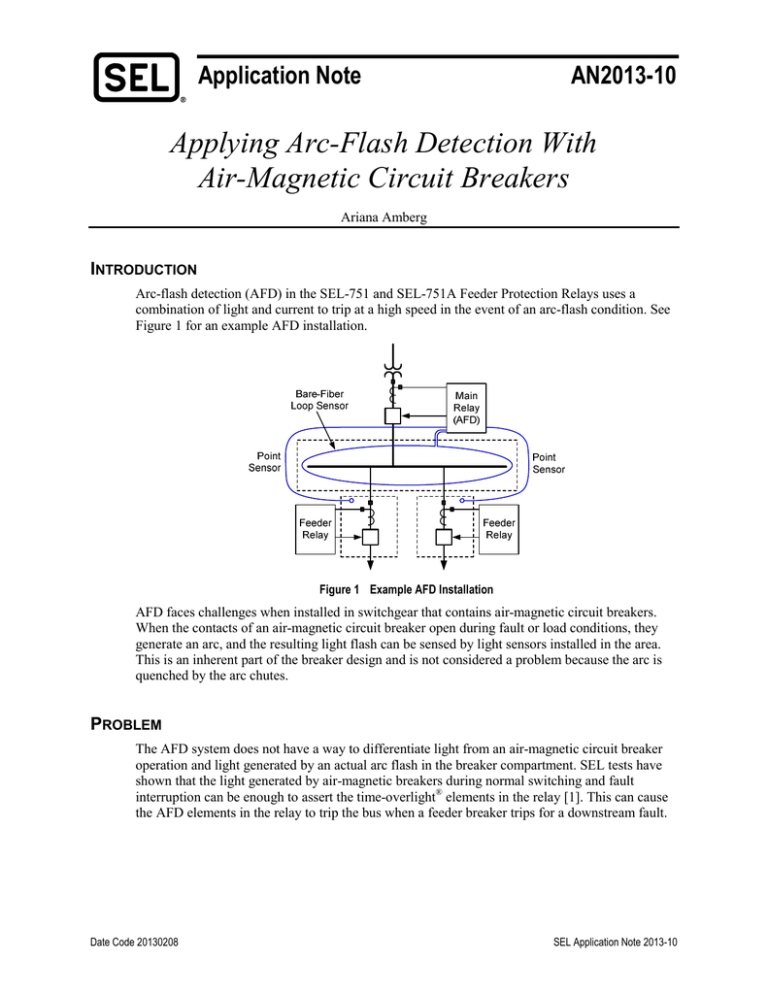
Application Note
AN2013-10
Applying Arc-Flash Detection With
Air-Magnetic Circuit Breakers
Ariana Amberg
INTRODUCTION
Arc-flash detection (AFD) in the SEL-751 and SEL-751A Feeder Protection Relays uses a
combination of light and current to trip at a high speed in the event of an arc-flash condition. See
Figure 1 for an example AFD installation.
Figure 1 Example AFD Installation
AFD faces challenges when installed in switchgear that contains air-magnetic circuit breakers.
When the contacts of an air-magnetic circuit breaker open during fault or load conditions, they
generate an arc, and the resulting light flash can be sensed by light sensors installed in the area.
This is an inherent part of the breaker design and is not considered a problem because the arc is
quenched by the arc chutes.
PROBLEM
The AFD system does not have a way to differentiate light from an air-magnetic circuit breaker
operation and light generated by an actual arc flash in the breaker compartment. SEL tests have
shown that the light generated by air-magnetic breakers during normal switching and fault
interruption can be enough to assert the time-overlight® elements in the relay [1]. This can cause
the AFD elements in the relay to trip the bus when a feeder breaker trips for a downstream fault.
Date Code 20130208
SEL Application Note 2013-10
2
SEL SOLUTION
One way to solve this problem involves sending trip signals from the individual feeder breakers
to the AFD relay. If the AFD relay is able to detect the arcs generated by the feeder breakers, it
should have a digital input wired to it that asserts when a feeder breaker is tripped by a protection
device. This input can be used to block AFD while the feeder breaker is opening. (When the AFD
current pickups are set to the recommended value of two times the load, the input does not need
to assert when the feeder breakers are manually opened during load conditions. Even though this
operation generates an arc, typical load values are not enough to trigger an arc-flash trip in the
AFD relay.) The time that passes between the feeder relays issuing a trip and the feeder breaker
actually opening (and the arc appearing) is at least 2 cycles, which is enough time to block the
AFD logic.
Trip signals from the feeder relays can be transferred to the AFD relay via copper wiring,
MIRRORED BITS® communications, or IEC 61850 Generic Object-Oriented Substation Event
(GOOSE) messaging. If the feeder protection does not have a programmable output contact or
another way to signal when it has issued a trip, this scheme cannot be implemented.
When the AFD relay is able to receive trip signals from the feeder relays, logic similar to the
following can be implemented in the AFD relay.
SV0x =
SV0xPU
SV0xDO
OUTxxx
IN102
= 0
= 0.1
= ((50PAF OR 50NAF) AND TOLn) AND (NOT SV0xT)
In this example, IN102 picks up when a feeder relay issues a trip to its breaker. The setting for
SV0xDO is dependent on the installation and should be greater than the time it takes for the arc to
be quenched. In SEL testing of a Westinghouse 150-DHP-750C 15 kV circuit breaker, the switch
arced for 4 cycles when interrupting a 10 kA fault [1]. A timing diagram of this process is shown
in Figure 2.
AFD Logic
Blocked
AFD Logic
Unblocked
SV0xDO
Time (cycles)
0
1
Downstream
Fault Occurs
2
3
4
2 Cycles
Feeder Relay
Issues Trip
5
6
7
8
4 Cycles of
Arcing Time
Feeder Breaker
Starts Opening
Feeder Breaker
Fully Open (Arc Gone)
Figure 2 Timing Diagram
It can be argued that the purpose of having a high-speed AFD system is defeated by deliberately
delaying the operation of the relay. However, the added time delay is not always in effectthe
elements are only delayed when a feeder breaker is being tripped by a protection device. If an arc
flash occurs at any other time, such as when the breaker truck is being racked in or out, the relay
senses the arc flash and sends a trip signal at its usual speed.
The main disadvantage of this solution occurs when a normal breaker operation evolves into an
arc-flash event due to a mechanical failure. In this case, the delay is in effect and the AFD relay
needs to wait for the SV0xDO time before it can issue a trip for the arc-flash event. However, the
overall improvement in safety that is gained from having 3-millisecond protection for the vast
majority of the time is worth the added delay that is necessary during a switching operation on
air-magnetic breakers.
SEL Application Note 2013-10
Date Code 20130208
3
REFERENCE
[1] B. Hughes, V. Skendzic, D. Das, and J. Carver, “High-Current Qualification Testing of an
Arc-Flash Detection System,” proceedings of the 9th Annual Power Systems Conference,
Clemson, SC, March 2010.
Date Code 20130208
SEL Application Note 2013-10
4
© 2013 by Schweitzer Engineering Laboratories, Inc.
All rights reserved.
*LAN2013-10*
SEL Application Note 2013-10
Date Code 20130208







